Input interpretation

N, N-dimethylformamide
Chemical names and formulas
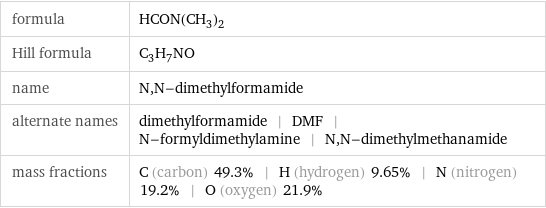
formula | HCON(CH_3)_2 Hill formula | C_3H_7NO name | N, N-dimethylformamide alternate names | dimethylformamide | DMF | N-formyldimethylamine | N, N-dimethylmethanamide mass fractions | C (carbon) 49.3% | H (hydrogen) 9.65% | N (nitrogen) 19.2% | O (oxygen) 21.9%
Lewis structure
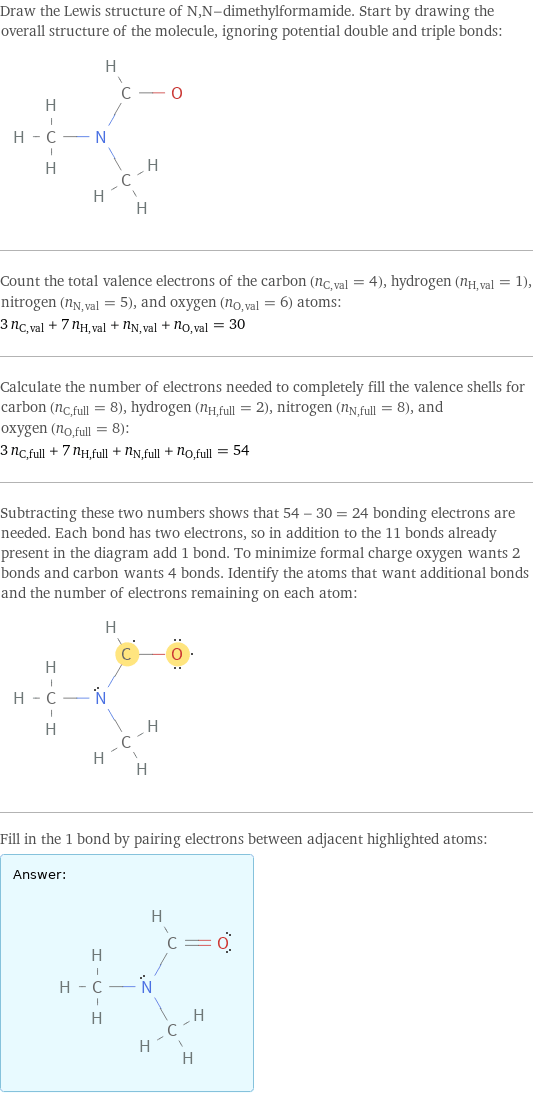
Draw the Lewis structure of N, N-dimethylformamide. Start by drawing the overall structure of the molecule, ignoring potential double and triple bonds: Count the total valence electrons of the carbon (n_C, val = 4), hydrogen (n_H, val = 1), nitrogen (n_N, val = 5), and oxygen (n_O, val = 6) atoms: 3 n_C, val + 7 n_H, val + n_N, val + n_O, val = 30 Calculate the number of electrons needed to completely fill the valence shells for carbon (n_C, full = 8), hydrogen (n_H, full = 2), nitrogen (n_N, full = 8), and oxygen (n_O, full = 8): 3 n_C, full + 7 n_H, full + n_N, full + n_O, full = 54 Subtracting these two numbers shows that 54 - 30 = 24 bonding electrons are needed. Each bond has two electrons, so in addition to the 11 bonds already present in the diagram add 1 bond. To minimize formal charge oxygen wants 2 bonds and carbon wants 4 bonds. Identify the atoms that want additional bonds and the number of electrons remaining on each atom: Fill in the 1 bond by pairing electrons between adjacent highlighted atoms: Answer: | |
3D structure
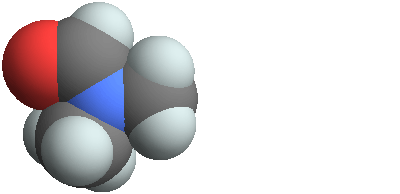
3D structure
Basic properties
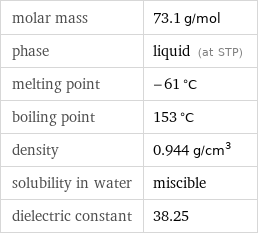
molar mass | 73.1 g/mol phase | liquid (at STP) melting point | -61 °C boiling point | 153 °C density | 0.944 g/cm^3 solubility in water | miscible dielectric constant | 38.25
Hydrophobicity and permeability properties

experimental LogP hydrophobicity | -1.01 predicted LogP hydrophobicity | -0.77 predicted LogS | 1
Basic drug properties

approval status | experimental | small molecule
Liquid properties (at STP)

density | 0.944 g/cm^3 vapor pressure | 2.7 mmHg dynamic viscosity | 7.94×10^-4 Pa s (at 25 °C) surface tension | 0.0352 N/m refractive index | 1.43 UV cutoff wavelength | 270 nm
Units
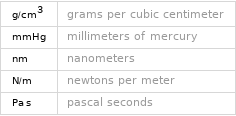
Thermodynamic properties
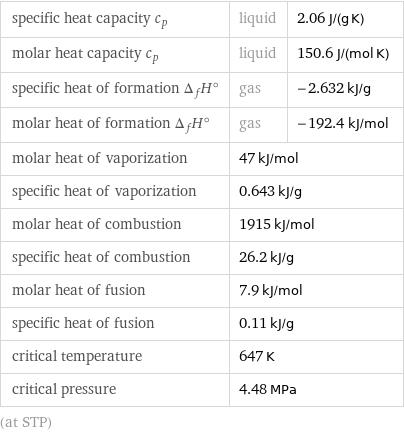
specific heat capacity c_p | liquid | 2.06 J/(g K) molar heat capacity c_p | liquid | 150.6 J/(mol K) specific heat of formation Δ_fH° | gas | -2.632 kJ/g molar heat of formation Δ_fH° | gas | -192.4 kJ/mol molar heat of vaporization | 47 kJ/mol | specific heat of vaporization | 0.643 kJ/g | molar heat of combustion | 1915 kJ/mol | specific heat of combustion | 26.2 kJ/g | molar heat of fusion | 7.9 kJ/mol | specific heat of fusion | 0.11 kJ/g | critical temperature | 647 K | critical pressure | 4.48 MPa | (at STP)
Chemical identifiers
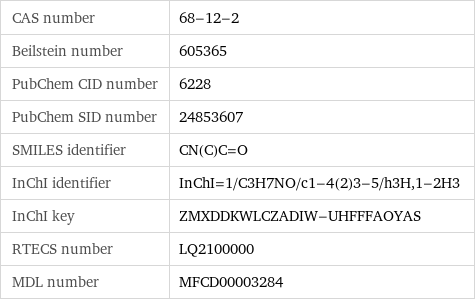
CAS number | 68-12-2 Beilstein number | 605365 PubChem CID number | 6228 PubChem SID number | 24853607 SMILES identifier | CN(C)C=O InChI identifier | InChI=1/C3H7NO/c1-4(2)3-5/h3H, 1-2H3 InChI key | ZMXDDKWLCZADIW-UHFFFAOYAS RTECS number | LQ2100000 MDL number | MFCD00003284
NFPA label

NFPA label
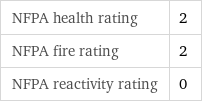
NFPA health rating | 2 NFPA fire rating | 2 NFPA reactivity rating | 0
Safety properties
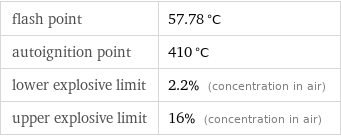
flash point | 57.78 °C autoignition point | 410 °C lower explosive limit | 2.2% (concentration in air) upper explosive limit | 16% (concentration in air)

DOT hazard class | 3 DOT numbers | 2265
Toxicity properties

lethal dosage | 1410 mg/kg (oral dose for rats) short-term exposure limit | 60 mg/m^3 threshold limit value | 10 ppmv

probable lethal dose for man | 600 mL (milliliters) long-term exposure limit | 30 mg/m^3 (over 8 hours) RTECS classes | tumorigen | mutagen | reproductive effector | primary irritant